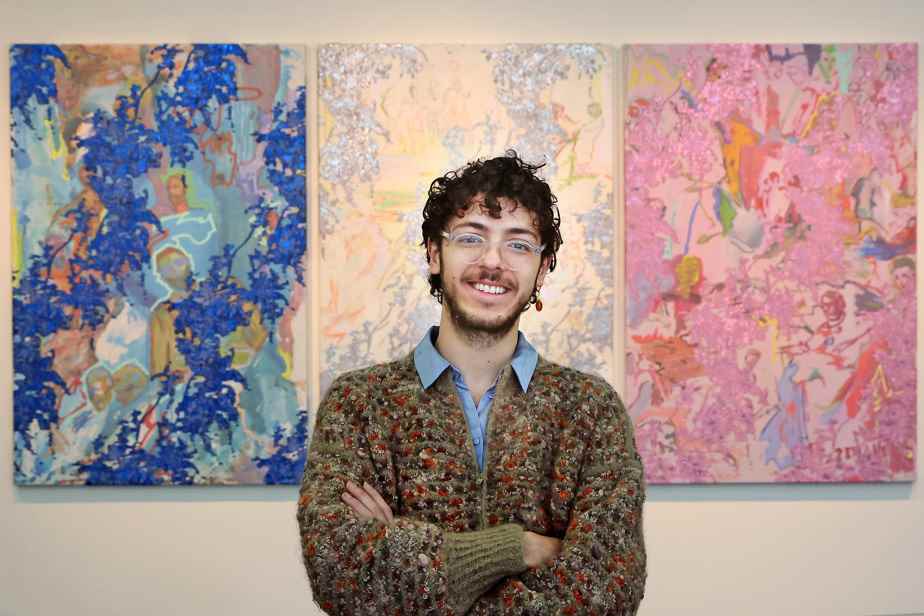Refreshing artistic proposals at the Maison des arts de Laval at the start of the year. The director of the Alfred-Pellan hall, Jasmine Colizza, has reserved the foyer space for Montreal artist Berirouche Feddal, who continues to arouse amazement. And the art center presents make communityan exhibition of female artists using print art to create.
We met Berirouche Feddal in his studio in April 2021. The Montreal artist of Kabyle origin hinted at a bright creative future. His new corpus, worship the golden calf, presented in Laval, confirms our predictions. At 26, he already has quite a few in his chest and does not lack imagination to give a relevant and pleasant appeal to both the form and the content of his art.
His new creations evoke the idols we adore or admire. Characters from the past, mythological figures or sports stars. These adorations, intrinsic to each of us, mark our identity. In six works, Berirouche Feddal approaches his roots, Algeria, Kabylie, colonization, decolonization, independence or even the role of sportsmen in the life of a country.

PHOTO ROBERT SKINNER, THE PRESS
In 1962, I left with MarianneBerirouche Feddal, 2022
In the painting In 1962, I left with Marianne, an Algerian child carries a bust stolen during a looting, at the time of the departure of the French from Algeria. He also symbolically represented a French flag and footballers in action in the triptych Inability to manage our feeling which speaks of the attachment of many Algerians to soccer players Karim Benzema and Zinedine Zidane, even if they wore the jersey of the colonizer. Covered with an Italian jacquard silk fabric, the painting is about the contradictions of patriotism, adoration, seduction and, according to Berirouche Feddal, about this political detachment that marks young Algerians today.
“Today, they favor personal relationships with others and take less account of historical and national heritage,” he says. We don’t look at who you are as a human anymore. »

PHOTO ROBERT SKINNER, THE PRESS
The imposing, imposedBerirouche Feddal, 2022, oil on canvas, acrylic and oil pastel, 279.4 x 172.2 cm
make community
Moreover, the artist, teacher and curator Andrée-Anne Dupuis-Bourret had been cooking up the idea of this exhibition for a long time. make community which combines both practices on the fringes of the visual arts and women artists of diverse origins.
The works of ten artists cover a broad spectrum of expression: from images to fanzines, including wallpaper, prints, installations and sculptures. A register that even goes as far as the participation of 500 children from Laval schools who, with their teachers, have created magnificent graphzines. The community aspect therefore casts a wide net thanks to the work of Liliane Audet, Education and Artistic Mediation Coordinator at Salle Alfred-Pellan.

PHOTO ROBERT SKINNER, THE PRESS
Some graphzines of selected Laval schoolchildren
Upon entering the room, we notice the installation by Jacinthe Loranger and Steffie Bélanger, a sort of hunting cache that incorporates art printed on paper, wood and fabric. But also carrot sculptures for deer!
-

PHOTO GUY L’HEUREUX, PROVIDED BY LA MAISON DES ARTS DE LAVAL
The installation of Jacinthe Loranger and Steffie Bélanger
-

PHOTO ROBERT SKINNER, THE PRESS
Some spirographic works by Emmanuelle Jacques
1/2
We continue with the station of Emmanuelle Jacques, Wealth Creation/Labour of Love, an exhaustive work resulting from the meetings of some forty artists to reflect on maternity, artistic life, the living conditions of artists, their relationship to the institutional, etc. Created with a spirograph, imitation banknotes and imitation diplomas contain messages on the importance of human relations to hide the harshness of the economic system for many artists. “It’s a cry from the heart,” says Jasmine Colizza.
The duo Jenny Lin and Eloisa Aquino, who often work in the world of zines, created Welcome to the Giddy Valley, a narrative mural, particularly on the queer community. There is also a composition by Dominique Pétrin with its characteristic prints. A kinetic work that contains a hidden message that we can perceive… with a lot of patience!

PHOTO ROBERT SKINNER, THE PRESS
The director of the Salle Alfred-Pellan, Jasmine Colizza, in front of the work of Dominique Pétrin
Near the work of Anna Jane McIntyre, a fresco with mythological forms, we find strange familiarity by Cynthia Dinan-Mitchell, a bittersweet work to watch closely to better understand the encyclopedic universe of this fascinating artist.
-

PHOTO ROBERT SKINNER, THE PRESS
The thermochromic paper of Pascaline Knight’s installation
-

PHOTO ROBERT SKINNER, THE PRESS
strange familiarityby Cynthia Dinan-Mitchell
1/2
In contrast, a beautiful moment of breathing with Céline Huyghebaert and her small frames fixed to the wall. And that something you miss is about absence, emptiness, cavity. The exhibition ends with the intimate contribution of Pascaline Knight, in particular her offer to let us mark an ephemeral trace of ourselves on thermochromic paper. “A gesture that allows us to understand what an imprint is in printed art”, says Andrée-Anne Dupuis-Bourret.
At the Maison des arts de Laval until January 29
